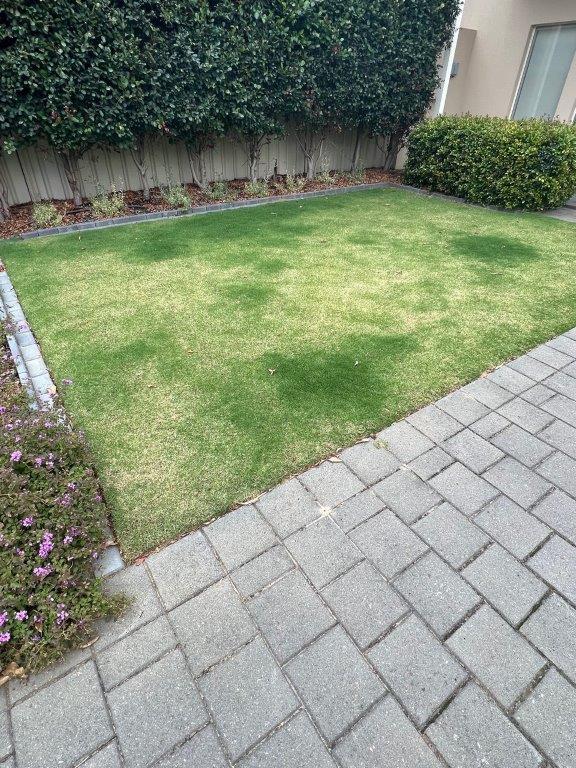Are you getting mixed results from your fertiliser?
Author: Stefan Palm Date Posted: 19 April 2023
While fertilising has a lot of benefits for lawns, the most recognised and the most expected is the greening effect. If your lawn doesn’t green up soon afterwards, you will likely conclude it didn’t work. If you've had this experience, there are reasons.
Autumn is a traditional time of year to fertilise your lawn, and for good reason. It helps retain colour for Winter and adds back vitality to deal with the rigours of the looming cold weather.
Sometimes your whole lawn fails to respond. Other times you’ll get a patchy effect where some areas green up more than others. We often get asked why this happens; believe it or not, there are some common reasons. Let me explain:
Incorrect pH
If your lawn simply isn’t responding to being fertilised, the answer could be incorrect pH. Maintaining soil as close to neutral as possible is essential so your lawn gets the nutrients it needs to thrive. Imbalances can result in an unhealthy and poor-looking lawn.
When soil becomes overly acidic or alkaline, certain nutrients become locked out and unavailable to the lawn. For example, if the soil were too acidic (e.g. had a pH of 5.5 or lower), elements like Nitrogen, Phosphorous and Potassium would become locked out, adversely affecting your lawn. You could tip fertiliser on by the truckload, but the lawn couldn’t access it. Similarly, if your soil was too alkaline (e.g. had a pH of 9 or higher), elements like Iron, Manganese, Copper and Zinc would be locked out. Only when a soil pH is around 7 are all essential minerals and elements available to the lawn.
Solution:
Perform a pH check on your soil. You can buy a simple pH kit or bring a soil sample to us for a free pH check. Soils that are too acidic can be corrected with garden lime, and soils that are too alkaline can be corrected with sulphur.
Non-wetting soil
It isn’t uncommon for soil under lawn to wet unevenly. Some parts of your soil will most likely absorb water quickly, and other parts may repel water altogether. Since water is that carrier for nutrients through the soil profile, if your soil repels water, it will also repel nutrients as well. It is common for this to appear in a distinct pattern in your lawn where the areas that absorb water properly look green and those that do not remain off-colour.
Solution:
Take a core sample of a poor-performing lawn and closely examine how much moisture is in the soil part of the core. Compare that to a core sample from a green area. If you don’t have a coring tool, dig a sample out with a hand trowel. If one sample is dry and the other is moist, you have a non-wetting soil problem. Non-wetting soils can be corrected with the application of a liquid wetting agent. I’d recommend that you apply a wetting agent every time you fertilise. This will ensure even percolation of the fertiliser through the soil profile.
Variable length root system
Some lawns have areas that have deeper root zones in some parts of the lawn compared to others. This is particularly true in part-shaded lawns. The shaded areas will typically have shorter root zones, and the sunny areas will have longer, more developed root zones. The longer the root zone, the more the lawn can extract and hold nutrients. Shallow areas will absorb less nutrients and will not respond as well.
Solution:
Once again, dig a core sample from your lawn in a poor area and compare it to a core from a good area. Couch and kikuyu lawns should have relatively dense root zones down to about 100mm below the surface. Lawns can have shallow or variable-length root zones for several reasons. If your soil is non-wetting, the root zone will likely be shallow. As mentioned above, non-wetting soils can be treated with regular applications of liquid wetting agents (applied every six weeks during the warm seasons or each time you fertilise). If your lawn’s root zone is variable because of shade, you can improve the situation by introducing more light via pruning. Aside from this, you should use fertilisers with high potassium and phosphorous levels to encourage deeper roots.
Insect damage
The colour of a lawn can be affected by insects, particularly turf mites. Mites can suck the colour out of your lawn and leave it looking patchy in no time. Mites can be tricky to diagnose and treat. If you want to know more about this, please have a read of my blog on the subject.
When it comes to fertilising, you should see results within five to seven days, and the results should be even. If they are not and you’ve exhausted all of the above causes, bring down a core sample to our store at Hove and will help you to figure out what’s wrong.


